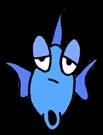Fish Diseases and Treatments
Home Page
Guestbook
Beginners Guide
Fish facts
Fish Diseases & Treatments
Gallery 1
Gallery 2
Photo of the month
Contact Page
FILTRATION FACTS
*Fishy Forum*
Here you'll fine diseases, diagnosis, and treatments
PARASITE
| Symptoms | Diagnosis | Treatment |
| Large white spots sprinkled like pretzel salt on body. Fish may be darting about and scratching on objects. | A protozoan parasite Ichtyophthirius, commonly called Ick, most frequently the result of a sudden temperature change. "Scaleless" fish are more susceptable to illness. | Malachite green solution for a minimum of 5 days, after which a water change should be performed. If tank has "scaleless" fish or small tetras, use 1/2 dose for a minimum of 7 days. NOTE: Although the spots disappear from the fish, do not stop treatment, this is normal due to the life cycle of this protozoan. |
| Tiny white or yellowish-white spots, may often appear like a dusting. Fish may be darting about and scratching on objects | A dinogflagellate parasite called Oodinium. | Malachite green solution or acriflavin for a minimum of 5 days. A combination remedy containing both Malachite and furazone will be more effective, as well as help treat any bacterial infections that result from the infestion. |
| Similar to Oodinium but less translucent, generally starts on dorsal area above head, affected fish are generally cichlids or livebearers. | A protozoan parasite Costia. | The most effective treatment is a remedy containing a combination of malachite green and dylox. If such a remedy is not found, a malachite-formalin complex can be used. |
| Emaciation, erratic swimming behavior, and loss of color, the loss of the red stripe on a neon or cardinal tetra is a giveaway. Affected fish are generally small tetras, but can include danios and barbs. | A protozoan parasite leading to the condition commonly called Neon Tetra Disease. | Treatment is difficult, a remedy containing nalagram has had the best results. A furazone-based treatment may be affective as well. |
| Small holes appearing particularly in the head region, affected fish tend to be cichlids, particularly discus and oscars. | A protozoan parasite Hexamita, leads to the condition commonly called Hole-in-the-Head Disease. | Usually the result of overcrowding, poor water quality, or overuse of feeder fish (in the case of large cichlids). So first remedy the cause, then treat with metronidazole added to the water (it is hard to find without a prescription, but it is available over the counter). NOTE: The scars may not heal completely after treatment. |
| Large parasite found most often on goldfish, may be 3/4" long and found attached to the body of the fish. | A crustacean parasite Lernia, commonly called Anchor Worm. | The organophosphate dylox (or a similar compound) to the water (care must be taken with this medication!), and manually remove the adult parasites from the affected fish. |
| Fish has translucent crab-like organisms measuring 1/2" in length scurrying about its body. Ponds are the most common sites for outbreaks. | A crustacean parasite called Argulus, commonly called Anchor Worm | The organophosphate dylox (or a similar compound) to the water (care must be taken with this medication!). Potassium permanganate may be used as an alternative treatment |
Fungus
| Symptoms | Diagnosis | Treatment |
| Greyish-brown cottony tuftftlike material covering body. May occur on a fish after injury. | True Fungus, normally caused by Saprolegnia. | If entire tank is affected, treat using a methylene blue solution or other proprietary TRUE fungus medication. If only one or few fish are afflicted, remove the fish and treat affected area directly with a methylene blue or malachite green solution, being careful not to let solution get into gills. |
| Thick greyish-white marks around mouth or body of fish | Mouth or Body Fungus, actually a bacterial disease usually caused by the bacterium Flexibacter. | A proprietary antibiotic containing erythromycin . |
Bacteria
| Symptoms | Diagnosis | Treatment |
| Red spots or streaks on body or fins of fish. | Septicemia and Ulcer Disease caused by bacteria including Pseudomonas, Aeromonas, and Vibrio. | If entire tank is affected, treat using a gram-negative proprietary antibiotic. It is recommended to feed the fish a medicated fish food containg an antibiotic, as the bacteria is most likely internalized as well. |
| Torn, ragged or stumpy fins, often edged in white. | Finrot usually caused by Pseudomonas, Aeromonas, | Treat using a gram-negative proprietary antibiotic. Placing a dab of methylene blue or malachite green directly on affected fins may help disinfect the areas and prevent secondary infections. |
| Bloated body, scales portrude from body, loss of appetite. Generally affects goldfish or african cichlids | Dropsy (goldfish) or Malawi Bloat (african cichlids). | The definite cause for this disease is unknown, so medication is difficult. A broad spectrum proprietary antibiotic coupled with the best possible water quality and food offers the best chance at treating these illnesses. |
Diagnosing fish disease
It is not possible to diagnose fish disease purely on the basis of behaviour or physical changes. These "clinical signs" that something is wrong can be useful as pointers to possible problems. However, many of these clinical signs can be caused by more than one disease condition, which is why further examination and tests are essential to make a definite diagnosis. Without any examination or tests, it is simply guesswork as to what is wrong!
The table below indicates some of the most common disease signs, and details further steps to take to help confirm a diagnosis.
